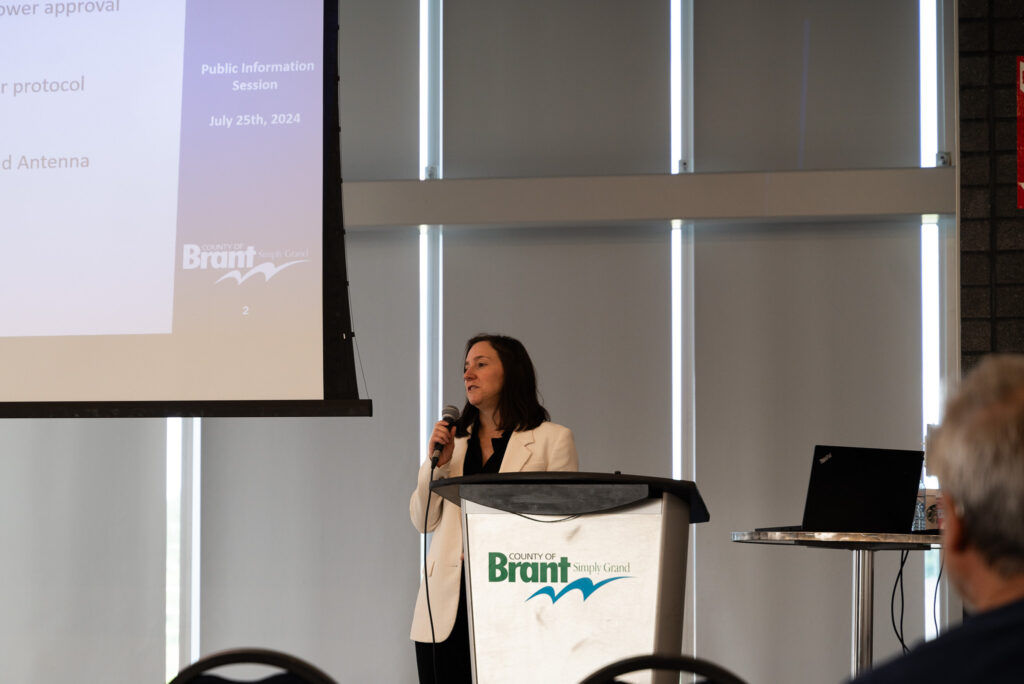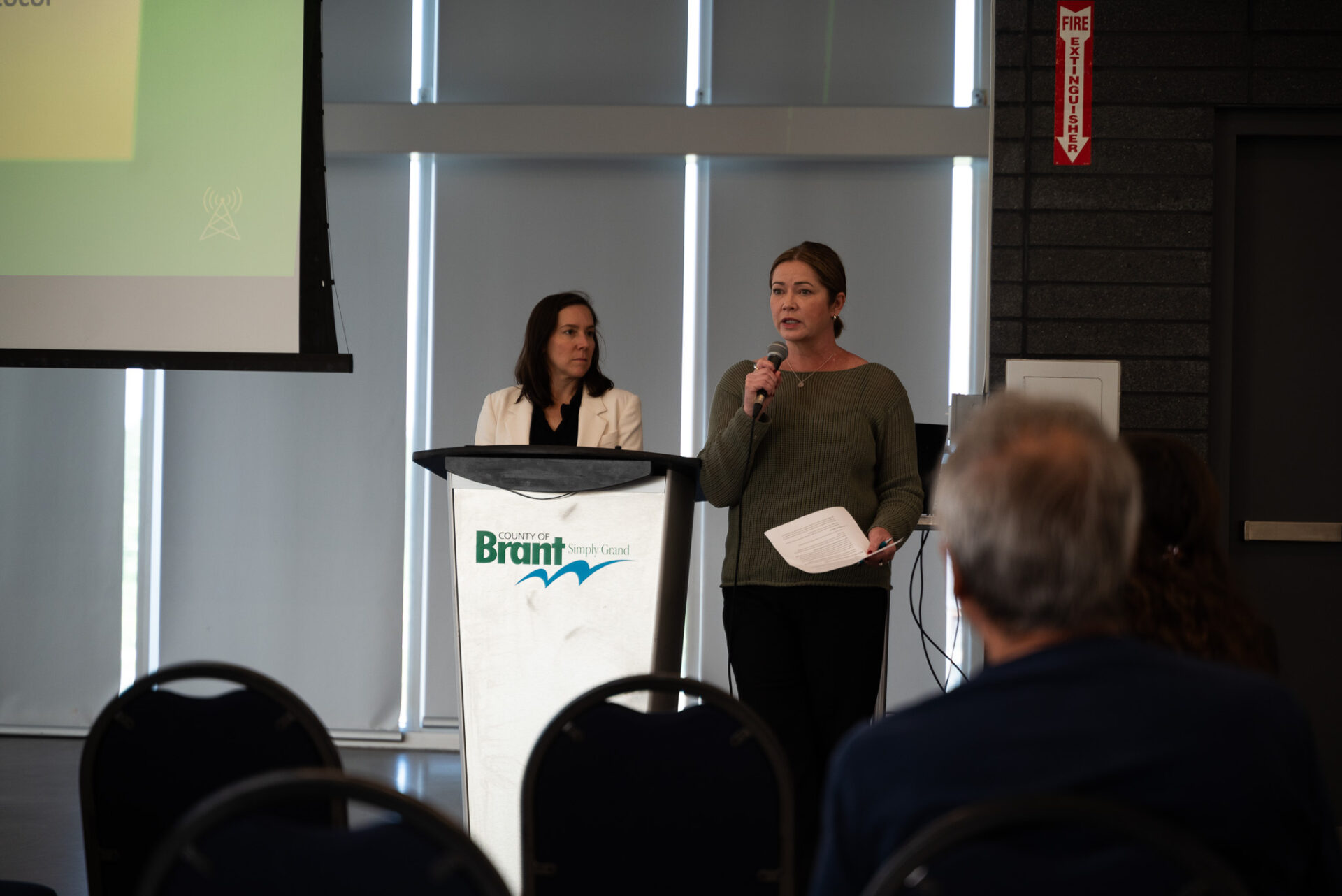Several County of Brant residents attended a public information meeting regarding streamlining and improving the process for installing telecommunications towers within the municipality on Thursday, July 25, 2024.
As part of the presentation, County Staff gave an overview of the process, as well as the potential changes to the County’s existing Communication Tower and Antenna Protocol.
Telecommunication towers are structures which support antennas that transmit and receive communication signals. The towers, which are federally regulated by Innovation, Science and Economic Development (ISED) Canada under the Radiocommunication Act, are used for mobile phones, radio, television, and other communication services.
According to ISED Canada, the federal process for building a telecommunication tower is as follows:
1. Share: Is a new tower necessary? Rules require companies to share towers, whenever possible, instead of building new ones.
2. Propose: Companies must submit a plan to the local municipality. *If they can’t share.
3. Notify: Once a company has a plan, it must notify local residents of the upcoming consultation following ISED’s or the municipality’s consultation process.
4. Consult: The company must consider the community’s views. Impasses are rare. Less than 0.1% of cases require ISED Canada’s decision.
5. Build: Following the consultation, and once the company and local municipality agree, the tower must be built within three years.
As far as step four goes, Alysha Dyjach, Acting General Manager of Development Services for the County, said that once the applicant engages with the community, they are to come back to the municipality to present their official proposal package.
“This is when it would come before the council and committee for a recommendation and that recommendation isn’t a normal planning act recommendation; all that it is saying is whether or not the County concurs with the location,” she said. “The municipality would then send off a letter saying that we could look at either a letter of concurrence or a letter of non-concurrence, and then at the end of that, the applicant returns with all of that information back to the ministry. There are requirements to meet like radio frequencies criteria, there’s notification to broadcasting stations, there’s compliance with Health Canada, and safety codes, and all of that happens outside of the municipal process, so the municipality is not able to comment on that. Municipality is only able to comment with regards to land plan uses. …In essence, once all of that goes back, they submit their formal package, and then either the federal government awards their application and grants it, or they do not.”
Dyjach said that because the final decision is ultimately up to the federal government, if there was an impasse from the County, the ministry would act as a mediator between the municipality and the tower applicant.
“It’s a dispute resolution process, which is similar to other tribunals and so lawyers would be involved and they [the applicant] would make a case to the ministry,” she said. “In the event of an impasse, the minister makes an ultimate decision. It’s not the county who makes the ultimate decision.”

Negin Mousavi Barenjaghi, a Development Planning student with the County, explained that ISED and the federal government has encouraged municipalities to create their own tower protocols based on a guideline for land use authorities, and that the County’s latest protocol was adopted in 2020.
Barenjaghi said that with that in mind, the County has proposed the following changes to the current protocol:
- Delegated Authority for Streamlined Review Process: Authority to review and issue letters of concurrence or non-concurrence will be delegated to Staff, specifically the Director of Development Planning, Development Services Division.
- Reduced Setback Requirements: The required distance from residential dwellings, natural heritage system features, and other sensitive land uses will be changed to 1.5 times the height of the tower, down from the current 120 meters.
- Reduced Business Case Requirements: The need for an implementation plan, expected costs over the project’s lifespan, anticipated outcomes, benefits, revenues, and risk assessments in the justification report will be removed.
- Reduced Mail Notice Radius: The radius for mailing notices to residents will be reduced from 500 meters to 120 meters around the subject property.
- Reduced Parking Requirements: The requirement for providing one parking space at each new communication tower and communication antenna site will be eliminated.
- Provide minor wording adjustments to more accurately reflect new technology.
*NOTE, to view the entire document (proposed changes to the protocol are highlighted), please visit: https://tinyurl.com/CommunicationTowerProtocol
Following the presentation, Alison Newton, Chief Administrative Officer (CAO) for the County, opened the floor for any questions regarding the protocol.
She noted that while many in attendance were there with questions about health and safety, in the future, staff’s recommendations will only be related to land-use as the County can’t make decisions based on health and safety unless it relates to a tower potentially falling.
“From what I’ve heard, a lot of people have concerns about health and safety around these towers and so I want to make it clear that the purview lies with Health Canada,” she said. “It certainly doesn’t mean that we can’t take that feedback, but we can’t make decisions in terms of the health and safety because that hasn’t been delegated to the municipality…we just don’t have control over that piece of the process. The municipality’s portion is strictly related to the local land use authority.”
Residents then took the time to voice their concerns about the proposed updates including:
- The protocol seemingly only benefits the applicant
- Why is the required distance between the tower and a residence being cut down from 120 metres to 1.5 times the height of the proposed tower?
- Radiation from the towers
- Insurance regarding falling infrastructure
- Why the decision about the towers are being delegated to Staff and not Council
- How will residents hear about a proposed tower if they don’t live within a 120 metre radius from the tower? and,
- Why are towers needed in the County in the first place?
Dyjach and Newton explained that the required distance being cut down is because of how 5G towers work (shorter towers can only provide service so far) and because they are streamlining their process with other municipalities.
The two noted that health and safety concerns regarding radiation should be directed to Health Canada; that applicants would have to insure their tower in the event it was to fall; staff would be making the decision instead of council in order to make the protocol non-discretionary; that residents can ask to be informed about any updates regarding proposed towers; and that the towers are needed because the federal government has made it mandatory.
Dyjach also suggested that those present should be submitting their questions and concerns so that staff can take them into consideration before the final draft of the protocol goes to council in the fall.
Kimberly De Jong’s reporting is funded by the Canadian government through its Local Journalism Initiative.The funding allows her to report rural and agricultural stories from Blandford-Blenheim and Brant County. Reach her at kimberly.dejong@brantbeacon.ca.
